home | internet service | web design | business directory | bulletin board | advertise | events calendar | contact | weather | cams

|
Here and There The Methow Valley is remote: making a living here historically has been a challenge. But these days “remote” has become just another word for a way to work. Thanks to the internet, people are moving to the Methow and bringing their jobs with them, quietly changing the local economy. 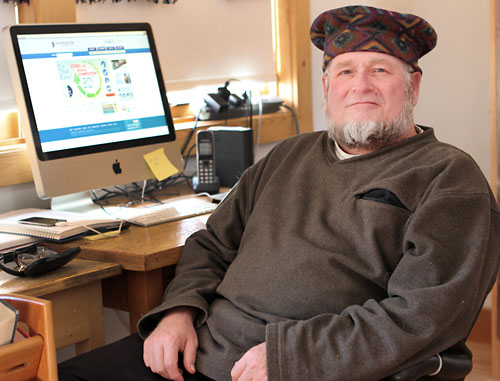 Winthrop software designer Dan Aspenwall first came to the valley in 1976. Winthrop software designer Dan Aspenwall first came to the valley in 1976.“I came to the valley with my job as soon as there was internet support for it,” says Dan Aspenwall, 59, a Winthrop software engineer. “Ever since I first came to the valley in 1976 I knew I would have to go make a job and bring it here,” he adds. He and his wife, glass artist Laura Aspenwall, moved here in 2002. Aspenwall, who formerly worked for IBM, is part of a three-man company, based in the Methow, Texas and San Francisco. They’ve designed a laptop computer rental kiosk for people who don’t want to lug around their own laptops, whether in universities or libraries. “Dragging around a personal laptop/netbook seems so 20th Century,” the firm’s website proclaims. Aspenwall also designs software for a firm in Tucson, Ariz., and designed an i-phone app used by hunters called Let Fly Ballistics, which calculates the flight of a rifle bullet. “It tells you how to adjust to aim for ranges in all weather,” he says. Aspenwall says he’s never seen the laptop rental lockers his company installs in such places as the San Francisco and Los Angeles libraries and the Columbia University Medical School in New York, and he has yet to meet one of the partners in the company face to face. The company’s machines can hold up to 48 laptops, and after each one is returned to its bay, all that user’s information is cleaned off and the device recharged, he says. From his home office in Winthrop, Aspenwall can keep a second-by-second, real-time eye on all the rental activity of every machine across the nation. 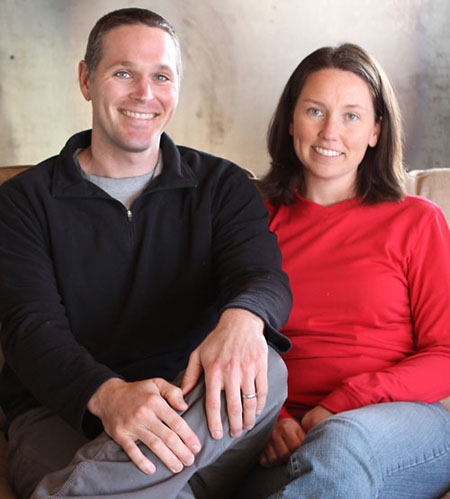 Software programmer Eric Godwin and architect Cara Godwin work remotely from Studhorse Mountain above Winthrop. Software programmer Eric Godwin and architect Cara Godwin work remotely from Studhorse Mountain above Winthrop.Eric Godwin, 36, and his wife Cara, 35, an architect who works remotely from Winthrop for her Seattle firm, arrived 18 months ago from Seattle. He works as a manager for Telenav, which designs GPS navigation products used by 34 million customers worldwide. The seven people he manages daily from his home in Winthrop live in Shanghai, Seattle and San Jose. Godwin writes programs for servers that aggregate real-time traffic information for customers such as the state’s Department of Transportation. The company’s mission, according to its website, is to help customers “make faster, smarter decisions about where to go, when to leave, how to get there, and what to do when they arrive.” He was working remotely for his California-based company while the couple lived in Seattle and spending every free moment they could recreating in the Methow. “It finally occurred to me: `Why am I living in Seattle and working remotely?” Godwin asked himself. He realized he could just as easily work remotely for the firm from the Methow. The couple made a five to seven year plan to get the money together for the move to the valley. “We made it in five years,” he says. For her, says Cara, the move is “going very well.” She goes to the office in Seattle once a month and says she’s found the transition seamless. One drawback of working from home is the lack of daily personal interaction with a tight-knit work community, says Godwin. But one of the couple’s goals in moving here was to “force a reprioritization” in their work-week lifestyle, he says. “I wanted to downshift and not be working the 60 hours I was doing.” Now, he adds, even with just stopping for a five-minute break, he’s restored by the sights and sounds of the Methow from their Studhorse home. “I love it. Absolutely, I love it.” 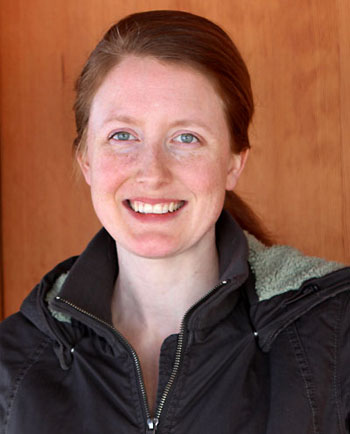 Rachel Carmichael's salary comes from Chicago. Rachel Carmichael's salary comes from Chicago.Rachel Carmichael, 32, of Twisp, works for a Chicago-based firm that helps people find eldercare, retirement and in-home help for the elderly through advertising-based website directories such as Years Ahead and Assisted Living Source. “I get money from Chicago and I spread it around the valley,” says Carmichael, who has a degree in classics from the University of Washington. Her title is sales manager, says Carmichael. “But I don’t really do a lot of sales.” She spends her time working from home with development teams, analyzing data, troubleshooting and providing customer service. Carmichael, now married with a new baby, came to the valley nine years ago after college graduation and took a summer job at the Duck Brand. Her parents had built a home here and she was familiar with the valley from her growing up years. During college she worked as a systems administrator and got experience with software and technology and acquired some computer programming skills, she says. She soon was hired by Winthrop-based homemovie.com and worked there for five years before she got her current job. “I never really thought I’d work from home like I do now,” she says, but neither did she expect to make her living with her classics degree. Carmichael says she’s well aware that many people in the valley have to cobble together a living wage from two or three part-time jobs, and says she feels fortunate to have one full-time, steady job with benefits. And while working at home with a baby poses its own management challenges, Carmichael says not having to look for daycare is another positive aspect of home-based remote employment. 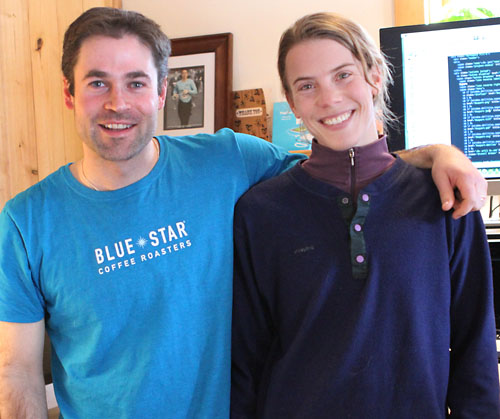 Software designer Dane Springmeyer and attorney Jen Marlow live off the grid and work remotely from an office in Winthrop. Software designer Dane Springmeyer and attorney Jen Marlow live off the grid and work remotely from an office in Winthrop.Software programmer Dane Springmeyer, 33, and his 32-year-old wife Jen Marlow, an attorney and adjunct professor at the University of Washington School of Law, moved from Seattle a few months ago to an off-the-grid rental house on Studhorse. “Why not come here?” he says. They are outdoors-oriented people and were attracted by the lifestyle, the people and landscape, he explains. Marlow adds that their social life here seems busier than it was in the city, where they often were working late into the night, even at home. In their Winthrop home, they make do with solar panels for electricity, a windmill for pumping water and propane for heat; they have no internet service at home. For their internet work, they rent an office in downtown Winthrop. Springmeyer’s salary comes to the valley from Washington, D.C., where Mapbox develops free, open source customized maps for such clients as environmental scientists or the National Park Service. The firm makes its money by hosting and maintaining the client’s map websites, explains Springmeyer. The internet allows him to chat with his home office all day, he says, so in that sense it’s very much like having the traditional office job. How’s the move working out for him? “Really good,” he replies. “We’re definitely doing better than in Seattle” in getting a balance between work and non-work life. “When you go home, you go home here,” adds Marlow. “I pretty much taught myself software development when Jen was in law school,” says Springmeyer, adding that now the couple is learning other skills, like how to stack wood and pump water. Marlow, who got her law degree at the UW’s law school, worked as co-director of Three Degrees Warmer, a project she helped start while a law student. The goal was to establish legal recourse for politically disadvantaged communities displaced by the effects of global warming. Kivalina, Alaska, a coastal community of 400, is an example, says Marlow. The village needs to be relocated because of melting permafrost, and flooding has destroyed the community’s water pipes. The village unsuccessfully sued a group of major oil companies to pay for the move, she says. Federal agencies such as FEMA are authorized to deal only with the effects of immediate catastrophes, not slow moving catastrophes like global warming, she notes. Thirty more Alaskan villages are facing the same fate, adds Marlow, who uses the internet to continue exploring legal avenues to address the consequences of global warming. ”My opinion is we need new laws,” she says. 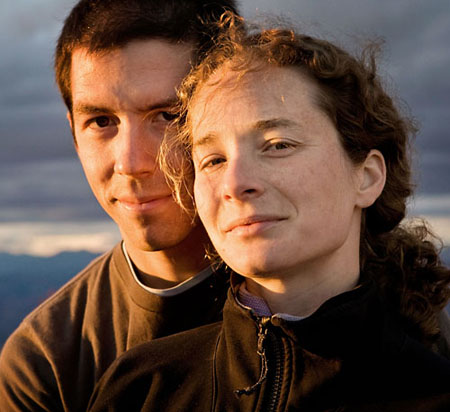 Benjamin Drummond and Sara Joy Steele serve clients all over the world from Upper Beaver Creek outside Twisp. Benjamin Drummond and Sara Joy Steele serve clients all over the world from Upper Beaver Creek outside Twisp.Benjamin Drummond, 33, and Sara Joy Steele, 34, helped persuade Springmeyer and Marlow to move to the Methow. Drummond and Steele brought their documentary film, photography and website development business, BDSJS.com, to Upper Beaver Creek outside Twisp two-and-a-half years ago. “We realized we could work from anywhere,” says Steele. “Our clients are all over the world.” They chose the Methow because they had been coming here for a decade for outdoor recreation “and really loved it.” They wanted to remain in Washington State and live in a smaller place than Seattle, she adds, one where they could ski, bike and hike. “The community of people who are here is really inspiring to us. We wanted to become part of that community,” Steele says. Before they formed their own company they worked at the North Cascades Institute. Drummond, a native of Wisconsin, and Steele, a native of Arizona who majored in English and biology, met at Carlton College, where they began the collaboration on projects that finally led them to form their own company. Trained as a geologist, Drummond decided on a career in photography, and his work has appeared in such publications as National Geographic, Smithsonian Magazine and Mother Jones, and their work has appeared in numerous galleries and exhibitions. Their clients are diverse, ranging from the Dublin Institute of Technology and the Washington State Department of Corrections to the National Park Service. They’re at work on a project of their own devising called Facing Climate Change which focuses on people living in areas impacted by changing climate. They travel the globe for projects – to Mozambique to document its first ophthalmologist, or to Scandinavia to record challenges facing Sami reindeer herders. “We’re in the field about 15 percent of the time,” says Steele. “The rest of the time we’re at the computer screen. We wanted to balance out the screen time with more time outside,” she explains. “It’s definitely working. It’s been wonderful.” 2/20/2013 Comments
|